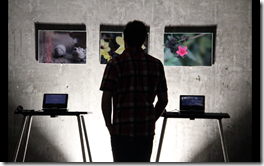Students Animating Fractals, Thinking on Pi and mental illness, and Cryptography? And it’s math class and art class too!
A curated multimedia exhibition entitled, “Illuminated Mathematics” produced by 12th graders may not be what you’d expect to see high school seniors working on. But at High Tech High (San Diego, CA) they are certainly taking a fresh approach to math and art (among other curricula). In Margaret Noble’s digital art class and David Stahnke’s math class, students created an intriguing exhibition combining sound, video, animation, photography and interactive installations with the goal of promoting math awareness through art, media and design.
The goal was to help students develop deeper connections to mathematical concepts and theory while connecting these concepts to the world at large and being able to communicate these concepts to their peers and community. Many teachers struggle with how to connect what they are teaching to the lives of their students. In this project a combination of student choice, not only in the math concept they explore, but also in the media arts output led to increased student buy-in and some extremely creative student work.
They first researched a math theory, narrative or phenomena including ideas like the Mysteries of Pi, is Math a Universal Language, Art, Nature & Fibonacci, Entropy and the Mathematics of Sports. Once deciding on a topic they researched, wrote a paper and presented a PowerPoint presentation to their class explaining their concept. Students then determined an approach to exhibiting their concepts through a digital art project using photography, sound, web sites or video.
The results were a creative array of video projects including animated fractals, chaos theory and relativity (separate exhibits), an artistic representation of tessellations, music produced using Pythagorean scales, photography that displayed entropy (ice melting in a warm room is a common example of increasing entropy – don’t worry, I just learned that too), Pi and mental illness in mathematics, and a silent film which used cryptography to crack a love letter, among a number of other creative choices. You can see much of this student work here on Ms. Noble’s blog. (scroll down). This work was exhibited for the public at a local performance and visual arts space.
What strikes me about this project, beyond the unique cross-curricula integration, are the educator’s abilities to let students drive the work. This can be an unsettling notion for many educators particular in math curricula were a linear, textbook-driven approach is often the norm. By turning the concepts over to students while offering intriguing hooks between these complex mathematical theories and elements of a student’s daily life, the level of engagement undoubtedly increased as evidenced by the creative output. Mr. Stahnke reflects on this aspect of teaching in an article he wrote, noting that by offering student’s a voice in their learning not only increases buy-in, but can have the effect of narrowing the achievement gap citing one student who struggled in math making significant strides during this project.
And playing off the theme of student voice, perhaps best to close with one student’s reflection on the project (borrowed from Mr. Stahnke’s article):
“It definitely widened my view of math. At first I thought math was only useful to scientists and mathematicians, but this project showed me that math is everywhere.”
Now I need to delve into animated fractals!
Regards,
Rob
Margaret Noble and David Stahnke will be exhibiting their “Illuminated Mathematics” project at the 2011 Partners in Learning U.S. Innovative Education Forum hosted at Microsoft’s worldwide headquarters in Redmond, WA later this month. To see other projects that will be featured at the event see my previous post.